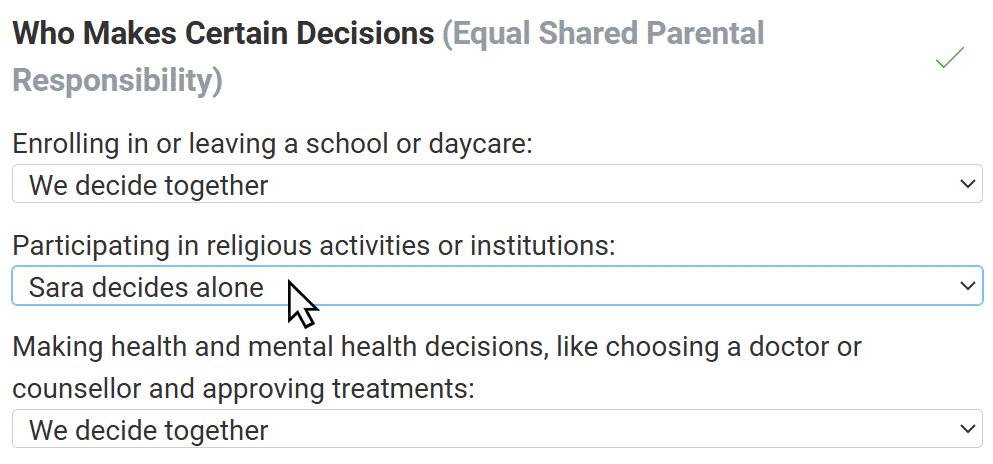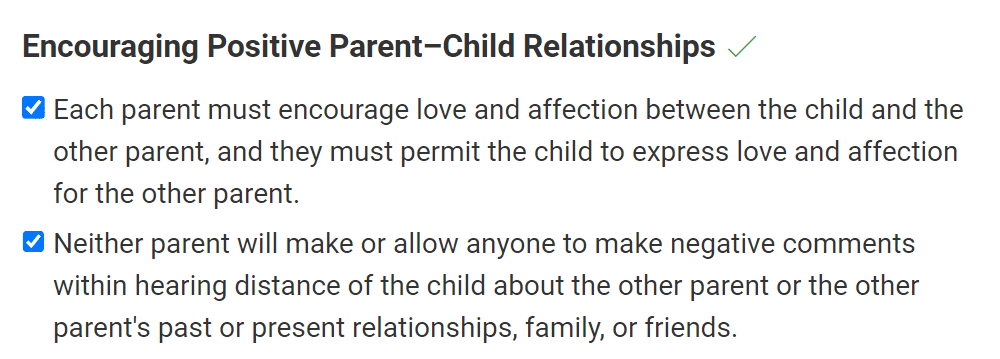Australia Parenting Plans: Making Your Agreement
A parenting plan is a written agreement between separated parents that sets out arrangements for their child. It covers topics like where the child will live and how the parents will reach decisions. It reminds parents what they agreed on and can also demonstrate their thinking to a court if they later have a dispute.
To empower a family court to enforce your plan, you can ask the court to issue consent orders reflecting the plan's terms — or just the terms you're most concerned about enforcing.
What to include in your parenting plan
Courts encourage separating couples to create parenting plans to avoid the complex and lengthy litigation process whenever feasible. However, the government does not say what a parenting plan must include or how it must look. As this is an agreement between parents, the parents get to decide its terms, as long as those terms are in the best interest of the child and don't break the law.
Draft your own proposed plan and bring it to discussions with the other parent so you can present your ideas quickly and clearly to them. You can reach agreement directly with the other parent or with help from an alternative dispute resolution method. If you can agree only on some issues related to your child, you can make a plan detailing your compromises, then have a court decide the remaining disagreements.
In your plan, use simple, clear language that is free of loopholes. To make this easier you can use the Custody X Change parenting plan template, which lets you select from over 140 common parenting plan clauses.
Parents who cooperate well usually have less-detailed plans than parents who quarrel frequently. When in doubt, more detail is better.
As you decide what to include, consider:
- Your child's well-being
- Your child's age and developmental stage
- Adjustments you might need as your child grows (Either write them in now or be prepared to make changes later.)
- Whether you want to try a plan temporarily to make sure it works
 You can customise this with Custody X Change.
You can customise this with Custody X Change.
In general, a thorough parenting plan should cover the following topics.
Living arrangements
A parenting plan should state whether the child will live with each parent or with one of the parents. If they live with only one parent, they should still spend time with the other. (Supervised parenting time can protect the child if necessary.)
The plan should explain the details in a parenting schedule that aims to disrupt your child's existing routine as little as possible. Make sure to address special occasions and school holidays.
 You can customise this with Custody X Change.
You can customise this with Custody X Change.
Australian law emphasises that a child should be allowed a meaningful relationship with both parents, but how this translates into parenting time varies by family.
Decision-making
Your plan should state how parents will share parental responsibility — the authority to make major, long-term decisions affecting your child.
If, like most parents, you agree to consult each other, write that you'll have equal shared parental responsibility. Detail how you'll deliberate together (e.g., by email or, in urgent situations, by phone call) and when (e.g., any decision to switch schools to happen during summer holidays).
Alternatively, you might agree that one parent should make these decisions alone. If so, write that this parent will have sole parental responsibility. More commonly, parents give one parent sole responsibility over certain topics (e.g. education), while they share responsibility for all other categories.
 You can customise this with Custody X Change.
You can customise this with Custody X Change.
If you'll ask a court for consent orders that include sole parental responsibility, explain in your application why sole responsibility is in your child's best interest, and affirm that each parent made the decision freely. By law, courts start from the presumption that equal shared parenting responsibility is best for children.
Resolving disagreements
Where you agree to share decision-making, specify how you'll resolve disagreements. Perhaps you'll see a family dispute resolution practitioner or ultimately leave the decision to one parent.
 You can customise this with Custody X Change.
You can customise this with Custody X Change.
Communicating with the child
Explain if and how the child will be able to communicate with the parent they're away from. You can also include rules for the child's communication with other people, such as grandparents.
Give as much detail as necessary to prevent confusion or conflict. During which hours will calling be allowed? How long may calls last? May the other parent listen in?
Changeovers
Specify how the child will get between parents' homes. For example, you could choose one of the following:
- The parent with the child will drop them off.
- The parent who isn't with the child will pick them up.
- One parent will always transfer the child.
If your case involves domestic violence, include safeguarding measures. For example, you might need to use supervised exchanges or hand over the child at a public place.
Health care
List any treatments and medications you agree the child should or should not receive, when parents must notify each other of the child's appointments, how you'll share health expenses, and similar details.

Other provisions
Your plan should cover anything else important to your family. You can add popular parenting provisions about things like travel abroad, as well as create custom rules. You can also use a parenting plan app to make sure you don't forget anything.
Don't forget that a parenting plan should always protect the best interests of your child. You might need provisions that emphasise this clearly, such as one stating that the child is free to express affection for both parents.
 You can customise this with Custody X Change.
You can customise this with Custody X Change.
Once you agree on a parenting plan
Once you've agreed on a plan with the other parent, keep it in a safe, accessible place. Refer to it whenever you have questions or parenting disagreements.
You may want to set a schedule for reviewing the plan with your co-parent to see if it needs updates — perhaps once a year. You can even make this a requirement in your parenting plan.
If the other parent doesn't comply with the plan, take notes in a parenting journal and gather evidence. You can use this information to take the issue to court. The parenting plan, which shows that the parent agreed to do things one way, will also serve as strong evidence for your position.
If you prefer to make your plan legally enforceable, apply together to have a court turn the terms into consent orders. Then the court will be able to issue penalties if a parent breaches the agreement.
Keep in mind that a parenting plan has more flexibility than a consent order. Plans are easy to change and can have any end date, as long as the parents agree on the change or end date.
If you can't agree on a parenting plan
If you cannot agree on a plan even after trying an alternative dispute resolution method, you'll need to ask a court for help.
A judicial officer (such as a judge) will then issue family court orders that determine your parenting arrangements.
The court process in Australia is long and fees are high, so only turn to court as your last option.
The easiest way to make a parenting plan in Australia
Creating a parenting plan on your own can feel overwhelming. You don't want to overlook important information.
Use technology to take the guesswork out of the equation. The Custody X Change co-parenting app walks you through each step of creating a comprehensive parenting plan.

The app also eases the difficult conversation about how to raise a child in two families. Having a structure to turn to reduces conflict and places the focus on your child's future.
The easiest and most reliable way to make a parenting plan is with Custody X Change.
